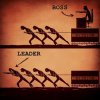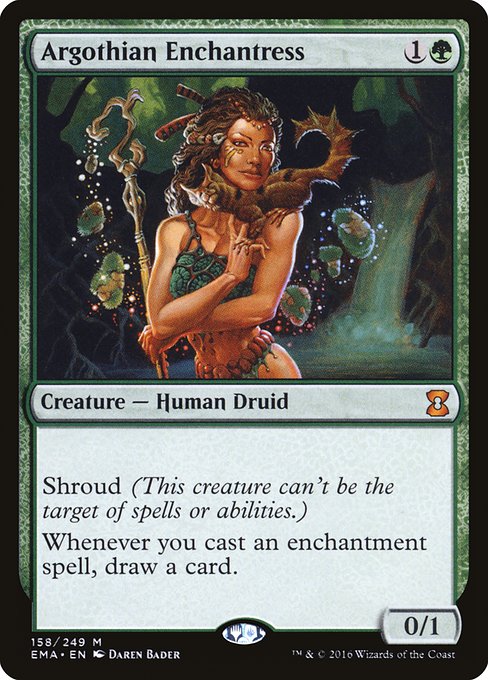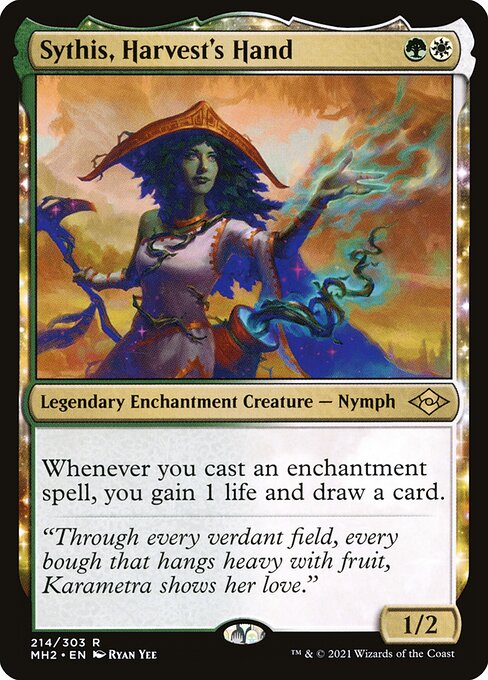I want to bring up a dichotomy in enablers and payoffs I have been paying more attention to in my latest cube changes. You have probably seen this meme before:

This difference can show in cards that look similar.

The cards in question:


(Cards: Argothian Enchantress, Sythis, Harvest's Hand.)
You know what I'm referring to, right? Here is another similar example:


(Cards: Disciple of the Vault, Psychomancer.)
One more, this time spicier?


(Cards: Third Path Iconoclast, Myth Realized.)
Enablers and payoffs want you to do something in order to get a reward. Some of them just sit there like bosses, waiting for other cards to work for them but not contributing to the deck except for their particular reward. Others also contribute to the theme and, like leaders, show by doing. Leaders also benefit from other thematic cards in their deck, but bosses don't cooperate with each other.
How important is that? Well, imagine we are playing some hypothetical Grixis artifacts deck. We draw our starting hand and it has three spells. Those are:



(Cards: Disciple of the Vault, Rise and Shine, Emry, Lurker of the Loch.)
We have a lot of things to do with artifacts, but nothing to start with. We depend on our draws and on what we mill with Emry after playing her at full cost (notably, this ability makes her not 100% a boss and gives her some leader quality.)
We decide we are better with a mulligan. Our new hand also has three spells. Those are:



(Cards: Psychomancer, Oni-Cult Anvil, Breya's Apprentice.)
Now we have everything we need to start our engines.
Before concluding, I would like to add something that bugs me about this idea. I might just be retreading the old distinction between payoff and enabler, but I see boss vs leader is at least a new axis of comparison. Is Sythis an enabler or a payoff? Well, it sure is a payoff, but it also has enabler qualities. What do you think of this?
So, with this dichotomy in mind, is it always better to have leaders instead of bosses? Well, it comes down to card comparison, of course. Sometimes the power between them is too different and other factors become more important: some of my examples are between monocolor and gold cards, which is obviously a non-trivial difference. Sometimes cards are not absolutely one or the other, as the previously mentioned Emry, Lurker of the Loch, which depends on the luck of what she mills, or Goblin Engineer, which brings something with him but still needs another artifact to start working. Also, as designers, we may not be searching for 100% consistency in our drafters' decks. Leaders can sometimes seem like they do all the work on their own and so they don't require as good a shell to be put in. A good number of leaders with some bosses here and there adds some interest to deckbuilding decisions and also makes so not all cards contribute in the same way, which would be more boring. As I heard Maro said, and I quote very liberally out of memory: "Why do we put restrictions on cards? Well, we are not designing for the most powerful game, we are designing for the most fun game."

This difference can show in cards that look similar.

The cards in question:
(Cards: Argothian Enchantress, Sythis, Harvest's Hand.)
You know what I'm referring to, right? Here is another similar example:
(Cards: Disciple of the Vault, Psychomancer.)
One more, this time spicier?
(Cards: Third Path Iconoclast, Myth Realized.)
Enablers and payoffs want you to do something in order to get a reward. Some of them just sit there like bosses, waiting for other cards to work for them but not contributing to the deck except for their particular reward. Others also contribute to the theme and, like leaders, show by doing. Leaders also benefit from other thematic cards in their deck, but bosses don't cooperate with each other.
How important is that? Well, imagine we are playing some hypothetical Grixis artifacts deck. We draw our starting hand and it has three spells. Those are:
(Cards: Disciple of the Vault, Rise and Shine, Emry, Lurker of the Loch.)
We have a lot of things to do with artifacts, but nothing to start with. We depend on our draws and on what we mill with Emry after playing her at full cost (notably, this ability makes her not 100% a boss and gives her some leader quality.)
We decide we are better with a mulligan. Our new hand also has three spells. Those are:
(Cards: Psychomancer, Oni-Cult Anvil, Breya's Apprentice.)
Now we have everything we need to start our engines.
Before concluding, I would like to add something that bugs me about this idea. I might just be retreading the old distinction between payoff and enabler, but I see boss vs leader is at least a new axis of comparison. Is Sythis an enabler or a payoff? Well, it sure is a payoff, but it also has enabler qualities. What do you think of this?
So, with this dichotomy in mind, is it always better to have leaders instead of bosses? Well, it comes down to card comparison, of course. Sometimes the power between them is too different and other factors become more important: some of my examples are between monocolor and gold cards, which is obviously a non-trivial difference. Sometimes cards are not absolutely one or the other, as the previously mentioned Emry, Lurker of the Loch, which depends on the luck of what she mills, or Goblin Engineer, which brings something with him but still needs another artifact to start working. Also, as designers, we may not be searching for 100% consistency in our drafters' decks. Leaders can sometimes seem like they do all the work on their own and so they don't require as good a shell to be put in. A good number of leaders with some bosses here and there adds some interest to deckbuilding decisions and also makes so not all cards contribute in the same way, which would be more boring. As I heard Maro said, and I quote very liberally out of memory: "Why do we put restrictions on cards? Well, we are not designing for the most powerful game, we are designing for the most fun game."


